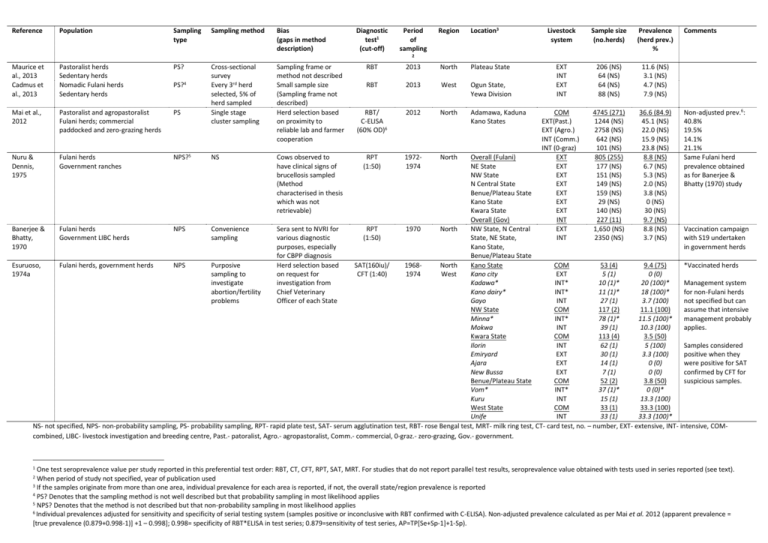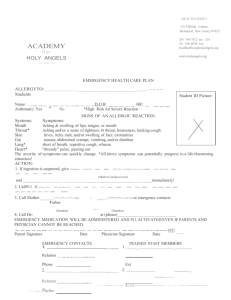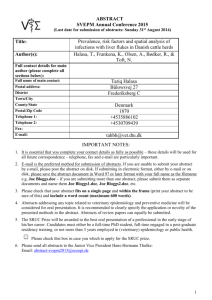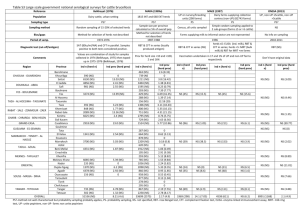Reference Population Sampling type Sampling method Bias (gaps
advertisement

Reference Population Sampling type Sampling method Bias (gaps in method description) Diagnostic test1 (cut-off) Period of sampling Region Location3 Livestock system Sample size (no.herds) Prevalence (herd prev.) % EXT INT EXT INT 206 (NS) 64 (NS) 64 (NS) 88 (NS) 11.6 (NS) 3.1 (NS) 4.7 (NS) 7.9 (NS) COM EXT(Past.) EXT (Agro.) INT (Comm.) INT (0-graz) EXT EXT EXT EXT EXT EXT EXT INT EXT INT 4745 (271) 1244 (NS) 2758 (NS) 642 (NS) 101 (NS) 805 (255) 177 (NS) 151 (NS) 149 (NS) 159 (NS) 29 (NS) 140 (NS) 227 (11) 1,650 (NS) 2350 (NS) 36.6 (84.9) 45.1 (NS) 22.0 (NS) 15.9 (NS) 23.8 (NS) 8.8 (NS) 6.7 (NS) 5.3 (NS) 2.0 (NS) 3.8 (NS) 0 (NS) 30 (NS) 9.7 (NS) 8.8 (NS) 3.7 (NS) Comments 2 Maurice et al., 2013 Cadmus et al., 2013 Pastoralist herds Sedentary herds Nomadic Fulani herds Sedentary herds PS? Mai et al., 2012 Pastoralist and agropastoralist Fulani herds; commercial paddocked and zero-grazing herds PS Nuru & Dennis, 1975 Fulani herds Government ranches NPS?5 PS?4 Cross-sectional survey Every 3rd herd selected, 5% of herd sampled Single stage cluster sampling Sampling frame or method not described Small sample size (Sampling frame not described) Herd selection based on proximity to reliable lab and farmer cooperation NS Cows observed to have clinical signs of brucellosis sampled (Method characterised in thesis which was not retrievable) RBT 2013 North Plateau State RBT 2013 West Ogun State, Yewa Division RBT/ C-ELISA (60% OD)6 2012 North Adamawa, Kaduna Kano States RPT (1:50) 19721974 North Non-adjusted prev.6: 40.8% 19.5% 14.1% 21.1% Same Fulani herd prevalence obtained as for Banerjee & Bhatty (1970) study Overall (Fulani) NE State NW State N Central State Benue/Plateau State Kano State Kwara State Overall (Gov) Banerjee & Fulani herds NPS Convenience Sera sent to NVRI for RPT 1970 North NW State, N Central Vaccination campaign Bhatty, Government LIBC herds sampling various diagnostic (1:50) State, NE State, with S19 undertaken 1970 purposes, especially Kano State, in government herds for CBPP diagnosis Benue/Plateau State Esuruoso, Fulani herds, government herds NPS Purposive Herd selection based SAT(160iu)/ 1968North Kano State COM 53 (4) 9.4 (75) *Vaccinated herds 1974a sampling to on request for CFT (1:40) 1974 West Kano city EXT 5 (1) 0 (0) investigate investigation from Kadawa* INT* 10 (1)* 20 (100)* Management system abortion/fertility Chief Veterinary Kano dairy* INT* 11 (1)* 18 (100)* for non-Fulani herds problems Officer of each State Gayo INT 27 (1) 3.7 (100) not specified but can NW State COM 117 (2) 11.1 (100) assume that intensive Minna* INT* 78 (1)* 11.5 (100)* management probably Mokwa INT 39 (1) 10.3 (100) applies. Kwara State COM 113 (4) 3.5 (50) Ilorin INT 62 (1) 5 (100) Samples considered Emiryard EXT 30 (1) 3.3 (100) positive when they Ajara EXT 14 (1) 0 (0) were positive for SAT New Bussa EXT 7 (1) 0 (0) confirmed by CFT for Benue/Plateau State COM 52 (2) 3.8 (50) suspicious samples. Vom* INT* 37 (1)* 0 (0)* Kuru INT 15 (1) 13.3 (100) West State COM 33 (1) 33.3 (100) Unife INT 33 (1) 33.3 (100)* NS- not specified, NPS- non-probability sampling, PS- probability sampling, RPT- rapid plate test, SAT- serum agglutination test, RBT- rose Bengal test, MRT- milk ring test, CT- card test, no. – number, EXT- extensive, INT- intensive, COMcombined, LIBC- livestock investigation and breeding centre, Past.- patoralist, Agro.- agropastoralist, Comm.- commercial, 0-graz.- zero-grazing, Gov.- government. 1 One test seroprevalence value per study reported in this preferential test order: RBT, CT, CFT, RPT, SAT, MRT. For studies that do not report parallel test results, seroprevalence value obtained with tests used in series reported (see text). When period of study not specified, year of publication used 3 If the samples originate from more than one area, individual prevalence for each area is reported, if not, the overall state/region prevalence is reported 4 PS? Denotes that the sampling method is not well described but that probability sampling in most likelihood applies 5 NPS? Denotes that the method is not described but that non-probability sampling in most likelihood applies 6 Individual prevalences adjusted for sensitivity and specificity of serial testing system (samples positive or inconclusive with RBT confirmed with C-ELISA). Non-adjusted prevalence calculated as per Mai et al. 2012 (apparent prevalence = [true prevalence (0.879+0.998-1)] +1 – 0.998]; 0.998= specificity of RBT*ELISA in test series; 0.879=sensitivity of test series, AP=TP[Se+Sp-1]+1-Sp). 2







